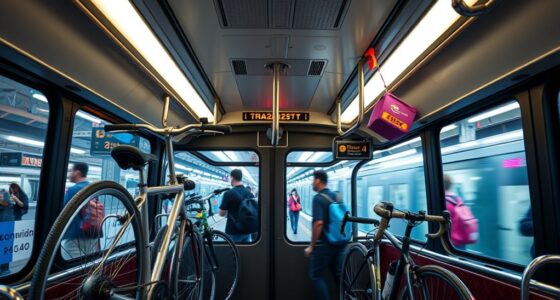To start commuting by bike, first check your bike’s tires, brakes, and chain for safety, and equip yourself with a helmet and reflective clothing. Plan bike-friendly routes using navigation apps, stick to bike lanes, and follow traffic laws. Ride confidently by practicing in low-traffic areas before tackling busier streets, and always stay aware of your surroundings. Keep experimenting with different routes and techniques—there’s much more to learn for a smooth, safe city cycling experience.
Key Takeaways
- Inspect and prepare your bike with proper inflation, brakes, lubrication, and safety gear before each ride.
- Plan routes using bike-friendly paths, starting with low-traffic streets for confidence-building.
- Follow traffic laws, ride in the same direction as traffic, and use hand signals for turns.
- Wear bright, reflective clothing and use front and rear lights to enhance visibility.
- Practice safe riding habits gradually, staying alert and maintaining patience to build skills and confidence.

Ever wondered how to navigate busy city streets safely and efficiently on your bike? Starting your city cycling journey might seem intimidating at first, but with a few key steps, you’ll gain confidence and enjoy the ride. First, make sure your bike is in good condition. Check the tires for proper inflation, ensure the brakes work effectively, and make sure your chain is well-lubricated. A well-maintained bike not only makes riding safer but also more enjoyable. Once your bike is ready, invest in safety gear, especially a helmet that fits snugly. Bright, reflective clothing or accessories will make you more visible to drivers, pedestrians, and other cyclists. Consider adding lights to your bike—white for the front and red for the rear—so you can be seen clearly, especially during dawn, dusk, or nighttime rides.
Familiarize yourself with local traffic laws related to cycling. Many cities have specific rules about riding on the road, using bike lanes, and signaling turns. Always follow traffic signals and ride in the same direction as traffic flow. When riding in bike lanes, stay within their boundaries and avoid swerving into traffic lanes unless necessary and safe to do so. Use hand signals to communicate your intentions to other road users. For example, extend your left arm to indicate a left turn or your right arm for a right turn. This helps drivers anticipate your movements and prevents accidents.
Follow traffic laws, use hand signals, and stay within bike lanes for safe city cycling.
Planning your route is essential. Start with familiar, low-traffic streets or designated bike paths to build confidence. Use navigation apps or maps that highlight bike-friendly routes, and always be aware of obstacles like potholes, debris, or parked cars that could cause accidents. Adjust your riding style to suit city conditions—stay alert, keep a safe distance from parked cars to avoid “dooring” accidents, and watch for pedestrians crossing unexpectedly. Be mindful of parked cars opening their doors suddenly, and stay vigilant at intersections, where most accidents occur. To improve your overall safety, consider tuning your bike to ensure optimal performance and responsiveness.
As you gain experience, gradually challenge yourself with more complex routes and busier streets. This will improve your skills and comfort level. Remember, city cycling isn’t just about getting from point A to B; it’s about enjoying the ride while staying safe. Keep practicing, stay aware of your surroundings, and wear your safety gear every time you ride. With patience and preparation, you’ll soon find that cycling through city streets becomes a rewarding and efficient way to commute.
Frequently Asked Questions
What Are the Best Bike Routes for Beginners?
You’re looking for the best bike routes for beginners, and that’s a smart start. Focus on quiet, low-traffic streets, bike lanes, and scenic paths with gentle slopes. Check local maps or cycling apps for recommended beginner routes. Start with short trips to build confidence, and choose routes with minimal intersections and good signage. As you gain experience, gradually explore busier routes to expand your comfort zone.
How Do I Secure My Bike Properly?
Imagine you’re leaving your bike outside a busy café, and you’re worried about theft. To secure it properly, you should use a sturdy U-lock around the frame and rear wheel, attaching it to a solid, immovable object. Avoid locking only the wheel, as thieves can often detach it. Combining a cable lock for added security and parking in well-lit, busy areas helps protect your bike effectively.
What Attire Is Suitable for City Cycling?
When choosing attire for city cycling, you want to stay comfortable and safe. Opt for breathable, moisture-wicking clothing that allows freedom of movement. Wear a well-fitted helmet, and consider bright or reflective gear for visibility. Layers are smart for adjusting to weather changes, and sturdy shoes with good grip help with pedaling and braking. Avoid loose clothing that could get caught in the chain or wheels.
How Can I Stay Safe in Traffic?
To stay safe in traffic, always stay alert and aware of your surroundings. Follow traffic rules, signal your turns clearly, and make eye contact with drivers when needed. Wear visible clothing and use lights and reflectors, especially at night. Keep a safe distance from vehicles, avoid blind spots, and stay predictable in your movements. Ultimately, confident riding and constant vigilance help you navigate traffic safely.
What Maintenance Does My Bike Need Regularly?
Sure, ignoring your bike’s needs might seem tempting, but neglecting regular maintenance isn’t a smart move. You should check tire pressure weekly, keep the brakes and chain well-lubricated, and regularly inspect for loose bolts or worn parts. Don’t forget to clean your bike, especially after muddy rides. These simple steps keep your ride smooth, safe, and ready to roll—because a well-maintained bike is a happy bike!
Conclusion
Think of city cycling like learning to dance. At first, the steps might feel awkward, and the rhythm unclear. But with each ride, you find your groove, weaving through traffic like a graceful partner. Before you know it, biking becomes second nature—your own dance across the city streets. So, lace up your shoes, hop on your bike, and start moving. The city’s rhythm is waiting for you to join the dance.









